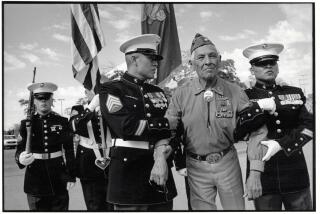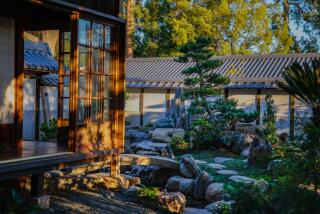Tea ceremony meets railroad
- Share via
The first countries to which the Industrial Revolution spread outside of Europe were the former colonies of Britain, and nowhere was this industrialization more successful than in the northeast regions of the United States. New England was the center of this expansion, which was accomplished at enormous social cost as the population of cities grew rapidly, with factories attracting workers as iron filings are drawn to a magnet. The conditions of factory life and the uprooting of the population resulted in estrangement and alienation that inspired an essentially escapist quest to find solace and meaning in variously constructed “other” realms.
It is understandable that those who were dissatisfied with their lives in the here-and-now should have indulged their wanderlust in pursuit of idealized domains. Often the quest was purely psychological; at other times, reports of earthly paradises inspired individuals to travel great distances in pursuit of their physical Shangri-Las. If one’s world seemed cold and heartless, for example, then solace might be sought and found in the passionate embrace of the warm waters of the South Pacific. Or, if one was troubled by the vulgar grittiness of secular American capitalism, meaning might be sought in the rarified spiritual aestheticism of a place like Japan.
This same world looked rather different when viewed from the Japanese perspective presented in Christopher Benfey’s “The Great Wave.” The relentless incursions of European and North American nations had provoked a foreign policy crisis for the earlier Tokugawa state. In the coup d’etat known as the Meiji Restoration of 1868, a coalition of the hereditary enemies of the Tokugawa shogun used the shogun’s inability to “subdue the barbarians” as their principal justification for ushering in a new era committed to national strengthening.
The attendant notion that Japan might be deficient relative to other countries was profoundly unsettling for the nation. Japan had for centuries been highly urbanized, with an excellent communications and transportation infrastructure, but what Japan in the mid-19th century was not was industrialized. This humiliating realization inspired what is styled the “Japanese economic miracle.” This was not a miracle at all; it was accomplished on the backs of ordinary people who bore unimaginable burdens on behalf of the state’s aspirations.
Japan faced a paradox. Its principal attraction to the elite of Europe and North America was its art. There was thus considerable incentive for the new Japanese state to represent itself as the repository of an artistic heritage that included such artifacts as the tea ceremony, woodblock prints, Buddhist sculpture and architectural monuments like the Tokugawa mausoleum at Nikko.
However, this art was culturally rooted in a feudal past that the new Japan wished to put behind, finding that though this exquisite heritage evoked admiration among many connoisseurs, it was the creation of railroads, gas lighting, a constitution and an elected legislature, as well as overseas colonies and military victories over China and Russia, that gave Japan a voice on the international stage. In this irony we can discern that binary representation of Japan memorialized in Ruth Benedict’s “The Chrysanthemum and the Sword.”
It is the story of how these two nations found each other that is so elegantly told by Benfey. On the one hand, we have the younger of the two nations, searching for meaning, wholeness and authenticity amidst the vulgar and superficial excesses of a Gilded Age whose onomastic achievements appeared little more than skin deep. And on the other hand, we have its elder contemporary in search of respect, appreciation and a place at the table of the world’s elite states.
Tales like this lack a clear beginning and a clear end, though Benfey focuses on the years between two momentous conflicts -- the end of the Civil War in the U.S. and the start of World War I in Europe -- resulting in a narrative that still has difficulty in achieving closure. But it is Benfey’s cast of characters that makes “The Great Wave” such fascinating reading, for characters they surely were. We find Commodore Matthew Perry approaching Nathaniel Hawthorne, then U.S. consul in Liverpool, for assistance in publishing his memoirs; Hawthorne instead recommended the services of the young Herman Melville, who had in 1841 tried to reach Japan at the same time that the Japanese adolescent later known as John Mung (for Manjiro) was rescued from the sea by Capt. William Whitfield. Manjiro returned to Japan in 1851, where he obtained samurai status in exchange for sharing his knowledge of the West, and resurfaced in 1860 as the navigator and chief interpreter of the first official Japanese mission to Washington, D.C., and New York.
Perhaps the closest to a protagonist in “The Great Wave” is the archeologist, zoologist and astronomer Edward Sylvester Morse, who became a serious student of Japan -- his authoritative “Japanese Homes and Their Surroundings,” for example, is said to have inspired Frank Lloyd Wright -- and who commissioned Mabel Todd to collect aboriginal Ainu artifacts in Japan (Todd also happened to be the first Western woman to climb Mt. Fuji).
Benfey’s narrative also describes those Westerners intent on preserving Old Japanese culture who heard Morse lecture on Japan at the Lowell Institute in Boston: Dr. William Sturgis Bigelow, the art collector who taught jujitsu grips to Theodore Roosevelt and whose cousin Clove married Henry Adams, the son and grandson of presidents who traveled to Japan in pursuit of Nirvana, and Percival Lowell, the astronomer who was best man at Edith Wharton’s wedding and whose study of Japan, “Soul of the Far East,” was described by Lafcadio Hearn as the “finest book on the East ever written.”
There is also Ernest Fenellosa, the foppish connoisseur of Japanese art who taught philosophy, political economy and logic at the newly founded Tokyo Imperial University, and, Isabella Gardner, the museum founder and adoring disciple of Okakura Kakuzo, whose “Ideals of the East” (1903) and “The Book of Tea” (1906) introduced Japan to Ezra Pound, Wallace Stevens and Frank Lloyd Wright and who enjoyed friendships with Rabindranath Tagore and T.S. Eliot. As all of these appear in Benfey’s complex narrative, one at times regrets the absence of a glossary.
“Japan,” Henry Adams complained to John Hay in 1886, “has been cleaned out.” The comment draws our attention to an unsettling fact well known to physical scientists, anthropologists and other professional observers: the act of observing affects that which is observed, and so nothing, once seen, is as it once was. In this sense, the “Old Japan” that formed the quest for so many in Benfey’s study vanished upon the moment of its discovery. This in turn, however, reminds us that the quest of Benfey’s cast, like that of so many others, has always been for something more imagined than real.
A professor of English at Mount Holyoke College, Benfey is understandably more competent in addressing the U.S. side than the Japanese side, and there are occasional mistakes that Japanophiles will find annoying. Benfey, for example, accuses Melville of having been “mistaken about the nonexistent island of ‘Matsmai’ ” -- a fact that Benfey describes as emblematic “of American ignorance of Japan in 1850” -- when in fact Matsumae was an actual castle town in southwest Hokkaido that served, in 1850, as a frontier outpost for Japanese colonization efforts.
Benfey similarly seems to confuse the male Benten, a kind of lucky god of prosperity, with Kannon when he describes Benten as “the goddess ... protector of seafarers,” and he twice identifies the 16th century tea master Sen no Rikyu as a 17th century figure. Perhaps his most troubling mistake is his description of a torii as “two vertical beams with a horizontal one balanced across them” (all torii have two horizontal beams), suggesting that if he has ever seen one, his recollection is at best imperfect.
These lapses notwithstanding, “The Great Wave” beautifully re-creates that distinctive fascination with Japan that so touched the hearts and minds of many on both sides of the Pacific. Much like a novelist, Benfey’s gift to readers is the manner in which he draws one so completely into an alternative realm that makes it difficult to return to the here-and-now. And in the process he shows us just what it was that so enchanted generations of the disenchanted and that continues to captivate successive generations of pilgrims to this very day.
More to Read
The biggest entertainment stories
Get our big stories about Hollywood, film, television, music, arts, culture and more right in your inbox as soon as they publish.
You may occasionally receive promotional content from the Los Angeles Times.










